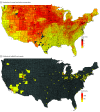Radon Exposure and Gestational Diabetes
- PMID: 39792382
- PMCID: PMC11724344
- DOI: 10.1001/jamanetworkopen.2024.54319
Radon Exposure and Gestational Diabetes
Abstract
Importance: Understanding environmental risk factors for gestational diabetes (GD) is crucial for developing preventive strategies and improving pregnancy outcomes.
Objective: To examine the association of county-level radon exposure with GD risk in pregnant individuals.
Design, setting, and participants: This multicenter, population-based cohort study used data from the Nulliparous Pregnancy Outcomes Study: Monitoring Mothers-to-Be (nuMoM2b) cohort, which recruited nulliparous pregnant participants from 8 US clinical centers between October 2010 and September 2013. Participants who had pregestational diabetes or were missing data on GD or county-level radon measurements were excluded from the current study. Data were analyzed from September 2023 to January 2024.
Exposures: County-level radon data were created by the Lawrence Berkeley National Laboratory based on the Environmental Protection Agency's short- and long-term indoor home radon assessments. Radon exposure was categorized into 3 groups: less than 1, 1 to less than 2, and 2 or more picocuries (pCi)/L (to convert to becquerels per cubic meter, multiply by 37). Because radon, smoking, and fine particulate matter air pollutants (PM2.5) may share similar biological pathways, participants were categorized by joint classifications of radon level (<2 and ≥2 pCi/L) with smoking status (never smokers and ever smokers) and radon level with PM2.5 level (above or below the median).
Main outcomes and measures: The main outcome was GD, identified based on glucose tolerance testing and information from medical record abstraction. Multiple logistic regression models were used to assess the association between radon exposure and GD.
Results: Among the 9107 participants, mean (SD) age was 27.0 (5.6) years; 3782 of 9101 (41.6%) had ever used tobacco. The mean (SD) county-level radon concentration was 1.6 (0.9) pCi/L, and 382 participants (4.2%) had GD recorded. After adjusting for potential confounders, individuals living in counties with the highest radon level (≥2 pCi/L) had higher odds of developing GD compared with those living in counties with the lowest radon level (<1 pCi/L) (odds ratio [OR], 1.37; 95% CI, 1.02-1.84); after additional adjustment for PM2.5, the OR was 1.36 (95% CI, 1.00-1.86). Elevated odds of GD were also observed in ever smokers living in counties with a higher (≥2 pCi/L) radon level (OR, 2.09; 95% CI, 1.41-3.11) and participants living in counties with higher radon and PM2.5 levels (OR, 1.93; 95% CI, 1.31-2.83), though no statistically significant interactions were observed.
Conclusions and relevance: This cohort study suggests that higher radon exposure is associated with greater odds of GD in nulliparous pregnant individuals. Further studies are needed to confirm the results and elucidate the underlying mechanisms, especially with individual-level residential radon exposure assessment.
Conflict of interest statement
Figures



Comment in
References
-
- Centers for Disease Control and Prevention . About gestational diabetes. Accessed February 10, 2023. https://www.cdc.gov/diabetes/about/gestational-diabetes.html?CDC_AAref_V...
-
- Shou C, Wei YM, Wang C, Yang HX. Updates in long-term maternal and fetal adverse effects of gestational diabetes mellitus. Matern Fetal Med. 2019;1(2):91-94. doi:10.1097/FM9.0000000000000019 - DOI
Publication types
MeSH terms
Substances
Grants and funding
- R01 NS122449/NS/NINDS NIH HHS/United States
- U10 HD063036/HD/NICHD NIH HHS/United States
- RF1 AG077255/AG/NIA NIH HHS/United States
- U10 HD063072/HD/NICHD NIH HHS/United States
- U10 HD063047/HD/NICHD NIH HHS/United States
- U10 HD063037/HD/NICHD NIH HHS/United States
- U10 HD063041/HD/NICHD NIH HHS/United States
- U10 HD063020/HD/NICHD NIH HHS/United States
- U10 HD063046/HD/NICHD NIH HHS/United States
- U10 HD063048/HD/NICHD NIH HHS/United States
- U10 HD063053/HD/NICHD NIH HHS/United States
- UL1 TR001108/TR/NCATS NIH HHS/United States
- UL1 TR000153/TR/NCATS NIH HHS/United States
LinkOut - more resources
Full Text Sources
Medical
Miscellaneous

